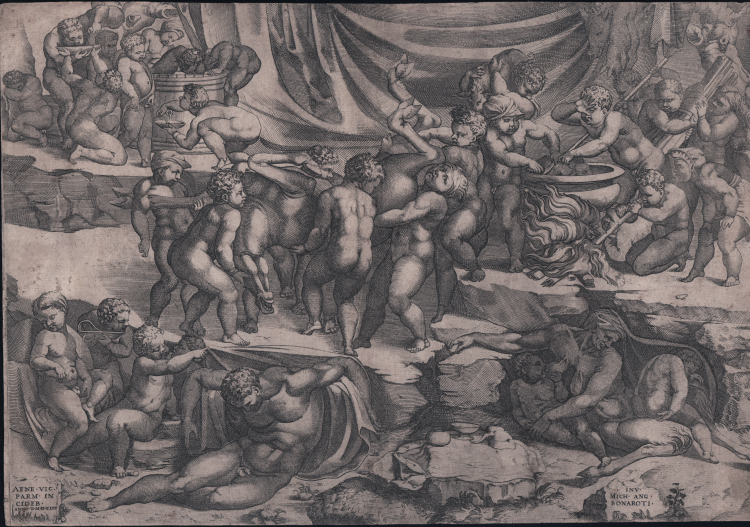




| Reference: | S41940 |
| Author | Enea VICO |
| Year: | 1546 |
| Measures: | 407 x 282 mm |



| Reference: | S41940 |
| Author | Enea VICO |
| Year: | 1546 |
| Measures: | 407 x 282 mm |
Engraving, 1546, bottom left on a stone «AENE.VIC. / PARM. IN / CIDEB. / ANNO. D. M.D.XLVI.». bottom right: «INV. / MICH. ANG. / BONAROTI.».
Example in the second final state. A fine impression,printed on contemporary laid paper, irregularely trimmed to the platemark, occasional spots, otherwise good condition.
The engraving derives from Michelangelo's red chalk drawing in the same direction, executed in 1533 for Tommaso Cavalieri, today at Windsor, Royal Library, inv. no. 12777.
The scene takes place on different levels of a rocky site, probably a cave, on the bottom of which is spread a large cloth. At the center, a group of putti - one is female and is the only figure that in some way is facing the viewer - drags an animal, identifiable in a doe, to sacrifice. Above, on the right, another group prepares a pot to cook a pig, while on the left the point of attraction is a vat, from which wine is poured in abundance. The unbridled, uninhibited vitality of these groups contrasts with the resigned, sleeping tone of the foreground: on the left, a frazzled panisca is suckling a putto; on the right, a young man, for some Silenus, is abandoning himself to a state somewhere between sleep and drunkenness, while a putto arranges a cloth behind his shoulders; in the center, on an animal skin, the head of a kid, a goblet and a cruet are laid out.
The interest of the engravers and print publishers of the sixteenth century for the "Baccanaria" of Michelangelo, is testified by three different engravings, made between 1546 and 1553, by Enea Vico, Nicolas Beatrizet (undated) and the anonymous one edited by Lafrery (1553).
There is no doubt that the prints of Vico and Beatrizet are related to each other:
although both stay fairly close to Michelangelo’s drawing with regard to the figures, there are significant variations in the drapery folds in the background as well as in vegetation and rocks in the foreground – both areas that printmakers would typically feel free to elaborate.
It is difficult to determine with certainty which of the two engravings preceded the other, but it is likely that the Vico engraving is earlier.
|
A. Alberti, in "D’ApresMichelangelo" , p. 147 n. 246 e vol 1, pp. 237-240; Bartsch XV.260.40; TIB 30, p. 67 n. 48; Barnes, pp. 63-64; Borea, p. 257.
|
Enea VICO (Parma 1523 - Ferrara 1567)
|
Enea, son of Francesco, was antique dealer, drawer, engraver and numismatist. He was born in Parma on January 29th, 1523, according to what Huber says. After the first school years in the city, and very likely after he made acquaintance with the works of Giulio Romano, Vico moved to Rome in 1541. He then worked for Tommaso Barlacchi, who also engraved with him a series of Grottesche, in 1542. In the classical atmosphere of Rome, Vico’s style developed according to that of Perin del Vaga and Francesco Salviati, but always with Parmigianino as main reference. Around the first half of the century and after studying the works of Marcantonio, Agostino Veneziano, Caraglio and Bonasone, Vico acquired his own, peculiar style which can be seen in his main works. From Rome Vico moved to Florence, where he worked for Cosimo I, and then went to Venice, in 1557. In 1563 he is already in Ferrara, working for Alfonso d’Este till his death in 1567.
|
|
A. Alberti, in "D’ApresMichelangelo" , p. 147 n. 246 e vol 1, pp. 237-240; Bartsch XV.260.40; TIB 30, p. 67 n. 48; Barnes, pp. 63-64; Borea, p. 257.
|
Enea VICO (Parma 1523 - Ferrara 1567)
|
Enea, son of Francesco, was antique dealer, drawer, engraver and numismatist. He was born in Parma on January 29th, 1523, according to what Huber says. After the first school years in the city, and very likely after he made acquaintance with the works of Giulio Romano, Vico moved to Rome in 1541. He then worked for Tommaso Barlacchi, who also engraved with him a series of Grottesche, in 1542. In the classical atmosphere of Rome, Vico’s style developed according to that of Perin del Vaga and Francesco Salviati, but always with Parmigianino as main reference. Around the first half of the century and after studying the works of Marcantonio, Agostino Veneziano, Caraglio and Bonasone, Vico acquired his own, peculiar style which can be seen in his main works. From Rome Vico moved to Florence, where he worked for Cosimo I, and then went to Venice, in 1557. In 1563 he is already in Ferrara, working for Alfonso d’Este till his death in 1567.
|